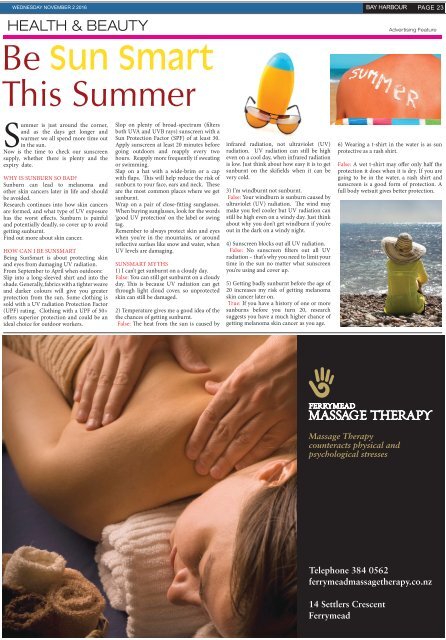Create successful ePaper yourself
Turn your PDF publications into a flip-book with our unique Google optimized e-Paper software.
2<br />
[Edition datE]<br />
Wednesday <strong>November</strong> 2 <strong>2016</strong><br />
BAY HARBOUR<br />
PAGE 23<br />
Be Sun Smart<br />
This Summer<br />
Summer is just around the corner,<br />
and as the days get longer and<br />
warmer we all spend more time out<br />
in the sun.<br />
Now is the time to check our sunscreen<br />
supply, whether there is plenty and the<br />
expiry date.<br />
WHY IS SUNBURN SO BAD?<br />
Sunburn can lead to melanoma and<br />
other skin cancers later in life and should<br />
be avoided.<br />
Research continues into how skin cancers<br />
are formed, and what type of UV exposure<br />
has the worst effects. Sunburn is painful<br />
and potentially deadly, so cover up to avoid<br />
getting sunburnt.<br />
Find out more about skin cancer.<br />
HOW CAN I BE SUNSMART<br />
Being SunSmart is about protecting skin<br />
and eyes from damaging UV radiation.<br />
From September to April when outdoors:<br />
Slip into a long-sleeved shirt and into the<br />
shade. Generally, fabrics with a tighter weave<br />
and darker colours will give you greater<br />
protection from the sun. Some clothing is<br />
sold with a UV radiation Protection Factor<br />
(UPF) rating. Clothing with a UPF of 50+<br />
offers superior protection and could be an<br />
ideal choice for outdoor workers.<br />
Slop on plenty of broad-spectrum (filters<br />
both UVA and UVB rays) sunscreen with a<br />
Sun Protection Factor (SPF) of at least 30.<br />
Apply sunscreen at least 20 minutes before<br />
going outdoors and reapply every two<br />
hours. Reapply more frequently if sweating<br />
or swimming.<br />
Slap on a hat with a wide-brim or a cap<br />
with flaps. This will help reduce the risk of<br />
sunburn to your face, ears and neck. These<br />
are the most common places where we get<br />
sunburnt.<br />
Wrap on a pair of close-fitting sunglasses.<br />
When buying sunglasses, look for the words<br />
‘good UV protection’ on the label or swing<br />
tag.<br />
Remember to always protect skin and eyes<br />
when you’re in the mountains, or around<br />
reflective surfaes like snow and water, when<br />
UV levels are damaging.<br />
SUNSMART MYTHS<br />
1) I can’t get sunburnt on a cloudy day.<br />
False: You can still get sunburnt on a cloudy<br />
day. This is because UV radiation can get<br />
through light cloud cover, so unprotected<br />
skin can still be damaged.<br />
2) Temperature gives me a good idea of the<br />
the chances of getting sunburnt.<br />
False: The heat from the sun is caused by<br />
infrared radiation, not ultraviolet (UV)<br />
radiation. UV radiation can still be high<br />
even on a cool day, when infrared radiation<br />
is low. Just think about how easy it is to get<br />
sunburnt on the skifields when it can be<br />
very cold.<br />
3) I’m windburnt not sunburnt.<br />
False: Your windburn is sunburn caused by<br />
ultraviolet (UV) radiation. The wind may<br />
make you feel cooler but UV radiation can<br />
still be high even on a windy day. Just think<br />
about why you don’t get windburn if you’re<br />
out in the dark on a windy night.<br />
4) Sunscreen blocks out all UV radiation.<br />
False: No sunscreen filters out all UV<br />
radiation – that’s why you need to limit your<br />
time in the sun no matter what sunscreen<br />
you’re using and cover up.<br />
5) Getting badly sunburnt before the age of<br />
20 increases my risk of getting melanoma<br />
skin cancer later on.<br />
True: If you have a history of one or more<br />
sunburns before you turn 20, research<br />
suggests you have a much higher chance of<br />
getting melanoma skin cancer as you age.<br />
6) Wearing a t-shirt in the water is as sun<br />
protective as a rash shirt.<br />
False: A wet t-shirt may offer only half the<br />
protection it does when it is dry. If you are<br />
going to be in the water, a rash shirt and<br />
sunscreen is a good form of protection. A<br />
full body wetsuit gives better protection.


















